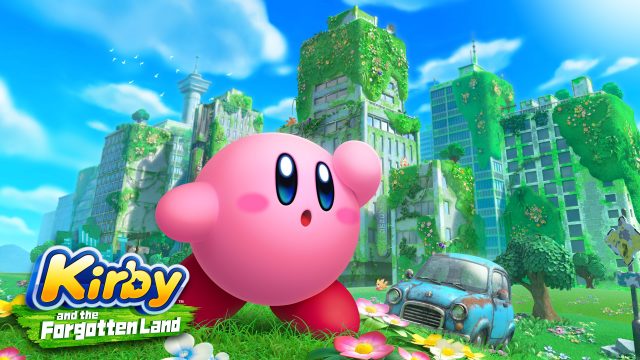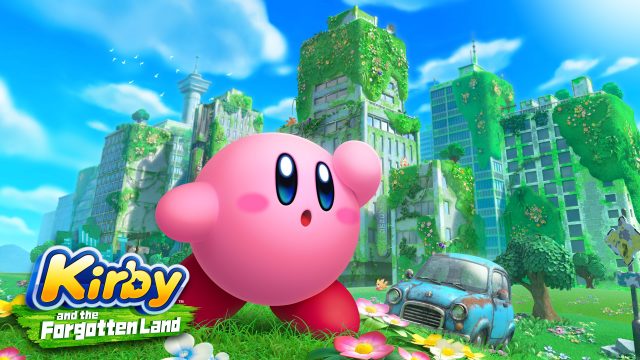The demo for Kirby and the Forgotten Land is available for download now in the Nintendo Switch eShop, so as one of my most anticipated games of the year I had to jump in and give it a go. I’ve been really excited for this game since it was announced during the September 2021 Nintendo Direct, but did the initial gameplay in the demo live up to the hype?
Yes. Yes it did.
The story starts with Kirby enjoying life on Planet Popstar, riding around on his Warp Star, when black clouds appear on the horizon and a rift in the sky suddenly opens, swallowing everything around into the void. Waddle Dees, including Bandana Waddle Dee, get sucked in, but so does Kirby despite his best efforts to zoom away. He awakens on the shore of a beach and, after a brief Majora’s Mask-ish walk through a hazy, dark, dreamlike forest, emerges in a cityscape sprawling before him.
This is Downtown Grassland, and the demo’s three stages are located here, from city streets and rooftops to the interior of a mall. Players can choose between two different difficulty modes before starting each stage: Wild Mode and Spring-Breeze Mode. They’re described as follows in-game:
- Wild Mode: A Kirby game that’s a bit wilder and more challenging. This adventure will be tough at times, but you’ll collect a lot of Star Coins as rewards!
- Spring-Breeze Mode: A Kirby game that’s simple to play! You’ll have a lot of health for this adventure. Perfect for those who are new to action games.
I played every stage on Wild Mode and while it wasn’t incredibly simple by any means, don’t be intimidated by “wild.” This mode isn’t difficult, it’s just more engaging for people who’ve played Kirby and action games before. It was enough of a challenge to keep me on my toes without feeling too simple or easy.
Point of Arrival, the demo’s first stage, does a very good job of seamlessly flowing from tutorial to gameplay. There are no intrusive text boxes that stop the action to explain your move set. Instead, as you run through the forest from the beach to Downtown Grassland, a small text box appears at the bottom of the screen with a simple, one-word command like “Jump” or “Inhale,” accompanied by a single image of Kirby performing that action and the button you need to press. For instance, as you approach the first part of the environment Kirby can jump on, the “Jump” pop-up appears, and when you approach your first enemy the “Inhale” pop-up appears.
The HUD in this game is really clean and minimal: at the start of each stage, Kirby’s health bar is briefly displayed in the upper left-hand corner while the number of Star Coins you have is in the upper-right. They quickly disappear, leaving nothing on-screen. When you obtain a Copy Ability, the name of the ability and the health bar and coin count briefly reappear, but then disappear again until you either lose or gain health or pick up coins. This is really nice for enabling not just unhindered visibility while fighting and exploring, but a clear view of the gorgeous environments.
Kirby and the Forgotten Land is a visually beautiful game. Textures, especially the water, are nicely rendered, with foreground and background blurring depending on the camera’s focus. For the most part, I never really needed to adjust the camera, which follows Kirby on its own, but there were times when I wanted to explore a little outside of where the game was trying to point me to next and I needed to manually adjust the camera to look where I wanted to look, not where it wanted me to look. I spotted one moment of graphical choppiness while looking at an enemy somewhat in the distance, but other than that everything ran smoothly and looked great.
Combat is really, really fun. Sword is the first Copy Ability you’re introduced to and Kirby can do a variety of actions using it, including a charged up spin attack that you can aim at an enemy, a multi-hit slash, and a mid-air somersault slash. Cutter, Freeze, and Bomb are also available in the demo, and once you complete all three stages you unlock the evolved forms, which you can try by replaying the levels. I enjoyed Sword and Cutter the most simply because I’m more of a hack-n-slash, beat-em-up type player and would rather just relentlessly beat enemies than craftily freeze or aim bombs. But Bomb was especially strong and really satisfying to use.
Speaking of abilities, the demo gives you a number of opportunities to try the new Mouthful Mode to inhale ridiculous things in the environment to solve puzzles and reveal secrets. Inhaling a car lets Kirby run over enemies and crash through walls, while inhaling a cone lets him use the pointed end to pierce cracked pipes and ground. Even vending machines become weapons once he inhales one and starts spitting out cans; vending machines have a limited number of cans each can shoot, but Kirby can pick up cans to restock his ammo supply. All of the Mouthful Mode abilities were really creative, easy and intuitive to pick up, and fun to use.
In the second level, Downtown Grassland, Kirby is tasked with finding all of the hidden Waddle Dees in the area. One is in plain sight and kicks off a mini-boss fight, while others are hidden inside various features of the environment and have to be broken free. I imagine this is likely going to be the format for most stages and the way players will rescue Waddle Dees to help rebuild their town. The nice thing was that every Waddle Dee was on my path and no backtracking was required to find all of them. This stage also introduces us to Elfilin, a mysterious flying creature who vows to help Kirby rescue the captured Waddle Dees.
One of my favorite features is collecting gashapon capsules Kirby can find throughout stages, which contain figurines of the game’s heroes and enemies with brief descriptions for some figures. It reminds me of the trophies in Smash Bros. Melee/Brawl/3DS and Wii U and is just a fun little feature that appeals to my own video game memorabilia collecting habits.
Completing the three demo stages brings rewards: you’ll get a Present Code to get extra items in the release version of the game, and you’ll get a second code if you finish all stages on Wild Mode.
Kirby and the Forgotten Land is shaping up to be a fantastic Kirby title, and likely my favorite in the series. While the demo is very short, we get sneak peeks into a number of different locations and the way in which nature has reclaimed this mysterious city, which is very intriguing. Combat was easy to pick up and gameplay was challenging enough to remain engaged for seasoned players on Wild Mode. And if you’re a sucker for the major cuteness of Kirby and his pals (like me), be prepared to be entrenched in it. (Seriously, Kirby, the Waddle Dees, and their enemies/frenemies have no business being as cute as they are).
If you blaze through the demo and find yourself craving more of this beautiful, mysterious world, don’t fret — Kirby and the Forgotten Land releases for Switch on March 25. Will you be picking up the game? Have you played the demo? What are your thoughts? Let us know below.
The post First Impressions: <em>Kirby and the Forgotten Land</em> Demo appeared first on Nintendojo.

